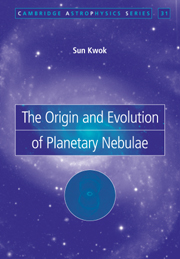Book contents
- Frontmatter
- Contents
- Preface
- 1 History and overview
- 2 Ionization structure of planetary nebulae
- 3 Nebular line radiation
- 4 Nebular continuum radiation
- 5 The neutral gas component
- 6 The dust component
- 7 Observations of the central star of planetary nebulae
- 8 Morphologies of planetary nebulae
- 9 Problems and questions
- 10 Asymptotic giant branch stars – progenitors of planetary nebulae
- 11 Evolution of the central stars
- 12 Formation of planetary nebulae
- 13 Dynamical evolution of planetary nebulae
- 14 Protoplanetary nebulae – the transition objects
- 15 Evolution to the white dwarf stage
- 16 Distances to planetary nebulae
- 17 Comparison between evolutionary models and observations
- 18 PN in the galactic context
- 19 Chemical abundances
- 20 Planetary nebulae in other galaxies
- 21 Concluding remarks
- References
- Appendix List of symbols and abbreviations
- Subject index
17 - Comparison between evolutionary models and observations
Published online by Cambridge University Press: 04 November 2009
- Frontmatter
- Contents
- Preface
- 1 History and overview
- 2 Ionization structure of planetary nebulae
- 3 Nebular line radiation
- 4 Nebular continuum radiation
- 5 The neutral gas component
- 6 The dust component
- 7 Observations of the central star of planetary nebulae
- 8 Morphologies of planetary nebulae
- 9 Problems and questions
- 10 Asymptotic giant branch stars – progenitors of planetary nebulae
- 11 Evolution of the central stars
- 12 Formation of planetary nebulae
- 13 Dynamical evolution of planetary nebulae
- 14 Protoplanetary nebulae – the transition objects
- 15 Evolution to the white dwarf stage
- 16 Distances to planetary nebulae
- 17 Comparison between evolutionary models and observations
- 18 PN in the galactic context
- 19 Chemical abundances
- 20 Planetary nebulae in other galaxies
- 21 Concluding remarks
- References
- Appendix List of symbols and abbreviations
- Subject index
Summary
The traditional way of comparing stellar evolutionary models and observations is through the Herztsprung-Russell (H-R) diagram. However, we should remember the H-R diagram has its origin in color-magnitude diagrams of stellar clusters, where all stars are at the same distance. For galactic and globular clusters, the stars have relatively small bolometric corrections, and therefore the luminosities and temperatures can be easily derived from apparent magnitudes and colors. The plotting of PN on the H-R diagram turns out to be a much more difficult task. In order for luminosities to be obtained, accurate distances and total fluxes are needed. CSPN have very high temperatures, and the conversion from visual magnitudes to bolometric magnitudes requires a large and uncertain correction factor. A large part of the stellar flux is transferred to the nebula, so the total emitted fluxes from the CSPN have to be inferred from the nebular spectrum. The accounting of the UV flux would be incomplete if the nebula is not ionization bounded. Furthermore, PN emit a large fraction of their total fluxes in the far infrared (see Section 6.2), and observations in the optical region alone are insufficient to account for all the emitted fluxes.
In spite of numerous efforts, the determination of distances to galactic PN remains uncertain to a large factor. Since many of the CSPN are not directly observable, their temperatures have to be inferred from the nebular properties.
- Type
- Chapter
- Information
- The Origin and Evolution of Planetary Nebulae , pp. 185 - 189Publisher: Cambridge University PressPrint publication year: 2000

